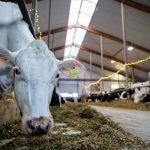
Dairy producer margins have risen to the highest level in a year and a half, according to the Milk Margin Above Feed Costs as calculated in the Dairy Margin Coverage (DMC) program.
“Increasing margins are good news for dairy producers and should send signals to them to increase output,” Monica Ganely, analyst with the Daily Dairy Report and founder and principal of Quarterra, an agricultural consulting firm in Buenos Aires. “However, well-publicized barriers, including animal health challenges, expensive financing, and a lack of replacement animals, are impeding the ability of U.S. producers to expand and capitalize on higher margins.”
May’s Milk Margin Above Feed Costs jumped to $10.52/cwt., an increase of 92 cents from April and the strongest margin since November 2022. “Depending on the level of coverage selected by a producer, the DMC program can result in payments when the margin falls below $9.50/cwt.,” Ganely said. “And May marked the third month in a row that no payments would be made.”
Stronger milk prices were responsible for much of the gain in dairy producer margins, but weakening feed costs also played a role. May’s All-Milk price rose to $22/cwt., up $1.50 from the previous month and the highest All-Milk price since January 2023, Ganley noted. The All-Milk price moved higher in response to increases in the Class IV price but especially in the Class III price, which climbed more than $3/cwt. compared to April. While spot dairy product prices have remained resilient, Ganely noted that futures markets suggest lower prices, especially Class III prices, could be on the horizon, she added.
May feed costs rose slightly compared to April levels but remain well below the lofty levels of the past few years, Ganley said. Feed costs as calculated by the DMC program rose 58 cents from April levels to $11.48/cwt. in May. All three feeds used in the calculation, corn, soybean meal, and premium alfalfa, rose. Despite the increases, though, May’s feed costs were nearly $3/cwt. lower than at the same time last year and were the lowest since 2021, she added.
“Despite higher margins, U.S. producers continue to face many barriers to expanding, but the longer margins stay at current levels, the greater the likelihood that resourceful producers will find ways to mitigate these challenges and increase production,” Ganley said.
One bearish factor for milk prices is lackluster U.S. dairy exports. In May, total U.S. exports fell below prior-year levels after growing in April, according to data from according to data from USDA’s Foreign Agricultural Service. U.S. exporters sent a total of 504.8 million pounds of dairy products offshore, 1.7% less than in May 2023. “Ongoing weak demand from Asia weighed on total exports, even as exports to Mexico continued to soar, Ganley said.
Cheese exports climbed 46.6% in May to 504.8 million pounds, the most ever recorded for the month. More than 40 million pounds of that cheese was sent to Mexico. Whey exports rose 15.2% as China’s demand for permeate and dry whey picked up, she added, but other dairy categories fared less well. Exports of nonfat dry milk, for example, slipped 24.2%, and butter exports fell 19.4% under the weight of high prices.
You can now read the most important #news on #eDairyNews #Whatsapp channels!!!
🇺🇸 eDairy News INGLÊS: https://whatsapp.com/channel/0029VaKsjzGDTkJyIN6hcP1K























